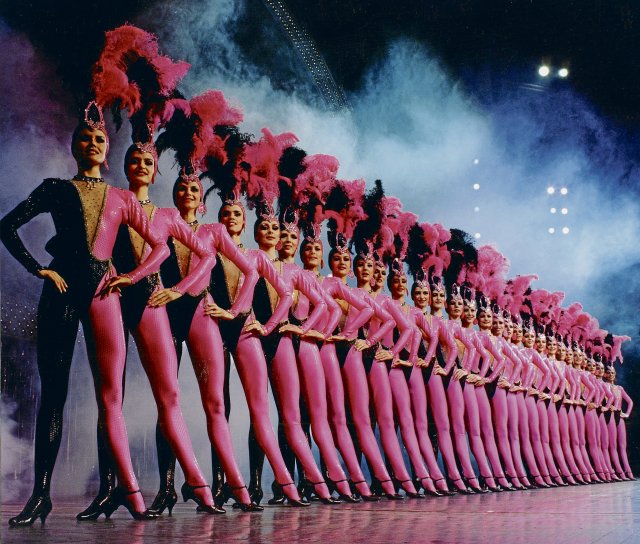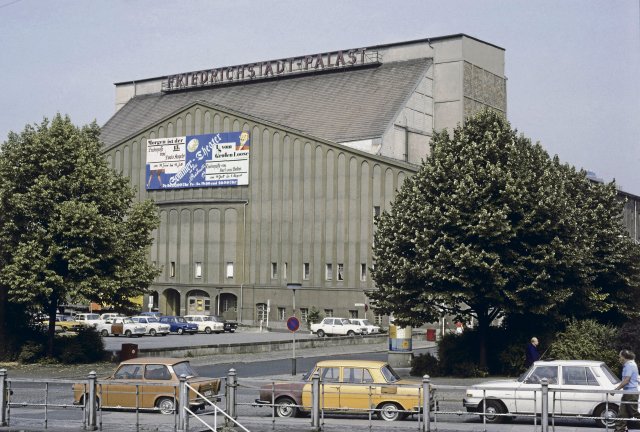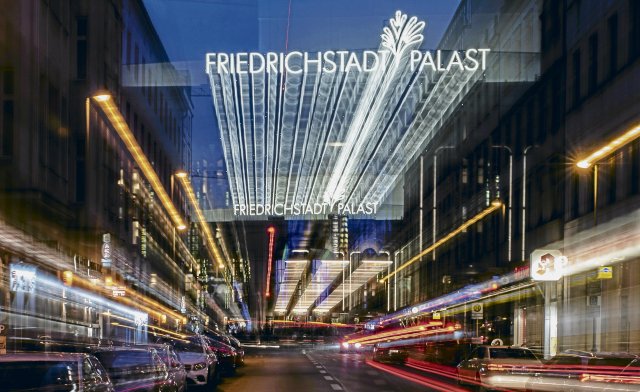The charisma of Berlin’s Friedrichstadt-Palast reaches around the entire globe.
Photo: dpa/Paul Zinken
In February 1990, a Hamburg news magazine headlined its swan song for the largest revue theater in the world outside of Las Vegas. It will perish “in the rubble of the workers’ and walled state.”
Well, the Friedrichstadt-Palast still exists: although it is only 40, it is already a listed building and is “in the black”. The majority of the audience travels from all over the country, mostly from “breathable experience spaces” with air-conditioned buses and no longer, as was once the case, “from the poisonous mists of the Leuna and Buna chimneys, from the dreariness of Zöschen, Schkopau and Kyritz, by bus “, train and groaning Trabis”. The tickets no longer cost between 7 and 15 GDR marks as they did back then, because, as the chatty news postille scornfully reported, the state subsidized each ticket with 45 marks. But it is uncertain “whether after March 18th the elected regents will continue to royally decorate the expensive glamor. Prices will rise nationwide.« For once, the West German assault gun of democracy was not wrong on this point. The ticket now costs between 19.80 and 199.90 euros, the equivalent of between 80 and 800 Ostmarkers… And the audience comes from all over the world.
The construction of the house was decided at the end of the 70s. The old Friedrichstadt Palace, built on oak planks in the alluvial sand of the Spree, sank into the glacial valley and could no longer be saved. Just over 100 years after it was built as a market hall, the building had already sunk half a meter. The tradition as a circus, large theater (under Max Reinhardt) and revue theater was coughed up; The building, known as the “stalactite cave” because of the cones that hung from the ceiling and the trusses, had to be closed by the building police.

The ballet – a trademark of the old and new Friedrichstadt-Palast
Photo: image/Gueffroy
It was decided, Erich Honecker, that the new palace would be built not far from the old palace, which was literally doomed. There was a suitable area between Friedrichstrasse and Kalkscheunenstrasse, Johannisstrasse and Ziegelstrasse, less than 8,000 square meters in size. There was once a barracks there that was designed by Schinkel. Then the tax office moved in, and by 1945 it was in ruins. When this was cleared away, the Barlay-Busch Circus pitched its tent and since 1963 only cars have been parked there. It was possible to build there.
On June 26, 1981, the foundation stone was laid in a 17 meter deep pit, and on April 27, 1984, the new Friedrichstadt Palace was opened. On time and on schedule. The only thing that wasn’t completely true to plan was the costs. Of the planned 219 million marks, five million had been saved. Today, as we know, everything works the other way around. The billion-dollar graves in Stuttgart, Hamburg, Berlin-Schönefeld etc. are well known…
Jürgen Ledderboge knows how this all became possible. The now 87-year-old was in charge. As senior construction manager, he sometimes directed up to 600 construction workers who worked in two shifts from 6 a.m. to 10 p.m. But Ledderboge shares the fate of most creators: her name never appears in the relevant publications. The architects Manfred Prasser and Dieter Bankert are praised, as is the general project manager Walter Schwarz and the general director of the capital’s building department Ehrhardt Gißke no less. That’s how it should be.
In contrast to these deserving personalities, the civil engineer Ledderboge is still pretty cool and, as a contemporary witness, knows how to happily report on the building history of the house. He has also started to write a book about it, but the many people who have to be asked about the rights to the photos and drawings have delayed its completion. After all, a book is not a building; everything is much, much more complicated.
On the one hand, the Friedrichstadt-Palast was a solitary building, but on the other hand it was just a building in the Friedrichstrasse North building complex, which also included residential and commercial buildings, kindergartens and a school. They were created at the same time. Ledderboge wore his hat there too. That’s why we know how, for example, they tapped into the district heating pipeline to the Charité in order to ensure that the line to the Friedrichstadt-Palast also ensured that the German Theater, university clinics, the “Johannishof” hotel and other new buildings in the neighborhood could also be supplied with heat and water. During the semester break, students dug cable trenches for two power lines that reached to the substations on the other side of Allee Unter den Linden. »We had planned eight weeks for each route, the young people only needed half the time. They were highly motivated,” says Ledderboge, still with undisguised pride. “They dug out the ditches and filled them back in – while traffic was still running.”

The “Stalactite Cave”, the old Friedrichstadt Palace with a parking lot
Photo: imago/Jürgen Ritter
But that alone didn’t bring about the savings in the millions. Those involved worked together to find original solutions that did not cost any foreign currency. »We couldn’t afford the planned facade made of steel, glass and aluminum. So we developed reinforced concrete elements with these colored glass silicate bricks. We decided not to use expensive wooden fittings inside and instead used concrete. To save energy, we installed skylights in the functional wing. Glass tubes from cattle milking plants were used for the lamp bodies in the foyer area, which designers, now known as designers, skillfully processed. We built sand-lime brick in the workshops and cloakrooms so that we didn’t have to plaster the interior walls…” So it was confirmed once again: Necessity is the mother of invention and gives birth to great things and therefore lasting ones.
nd.DieWoche – our weekly newsletter

With our weekly newsletter nd.DieWoche look at the most important topics of the week and read them Highlights our Saturday edition on Friday. Get your free subscription here.
And why does the palace look the way it does from the outside? Which led to the no less inventive visitors at the time giving it the nickname “Azerbaijani train station”. The original design was intended for a cultural center in Baghdad, reveals Ledderboge. If the journalists in Hamburg had known this, they would certainly have doubled over with scorn, since they were certainly already squirming about their word creations about the “Frohsinnskombinat” – which the humorous GDR citizens could definitely, put in a positive way, accept with pride – including the (this now disrespectfully) “palace-owned Hochbein Brigade”. But the joke spread by the Western press at the time is surpassed by Wikipedia. “With its 1,895 seats, the palace has been the largest theater building in Berlin since 1990,” it actually says. Since 1990!
“Was there any expansion after the fall of the Wall?” I ask Jürgen Ledderboge, the ex-senior construction manager. “Not that I know. We were already Berlin’s largest theater building in 1984.«
Subscribe to the “nd”

Being left is complicated.
We keep track!
With our digital promotional subscription you can read all issues of »nd« digitally (nd.App or nd.Epaper) for little money at home or on the go.
Subscribe now!
demo slot sbobet88 sbobet link sbobet
